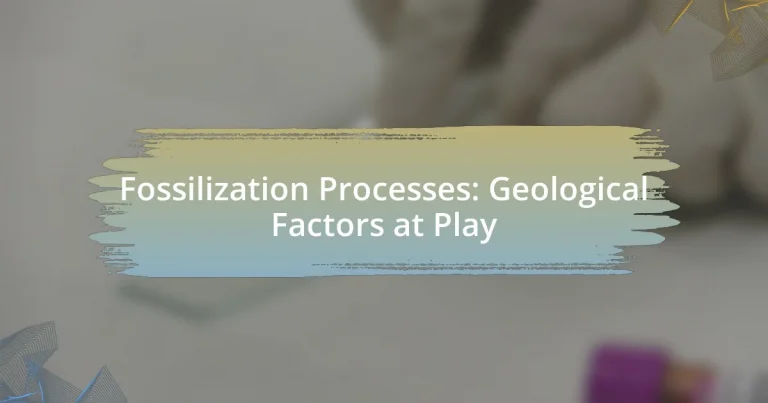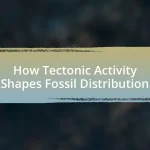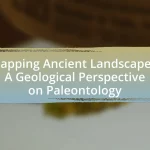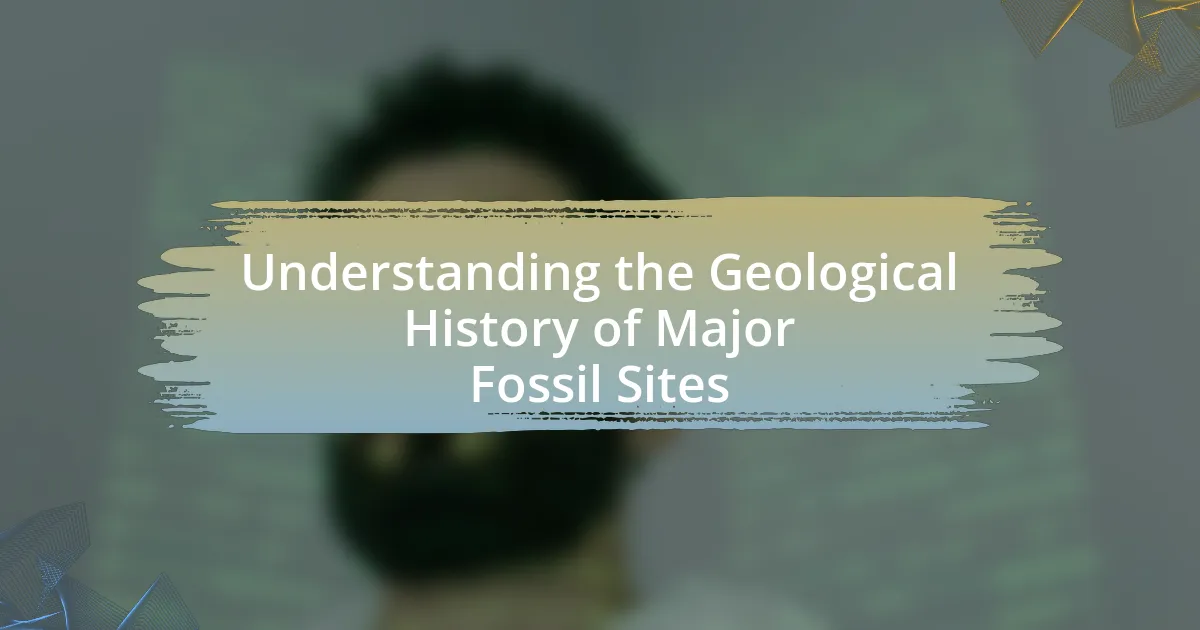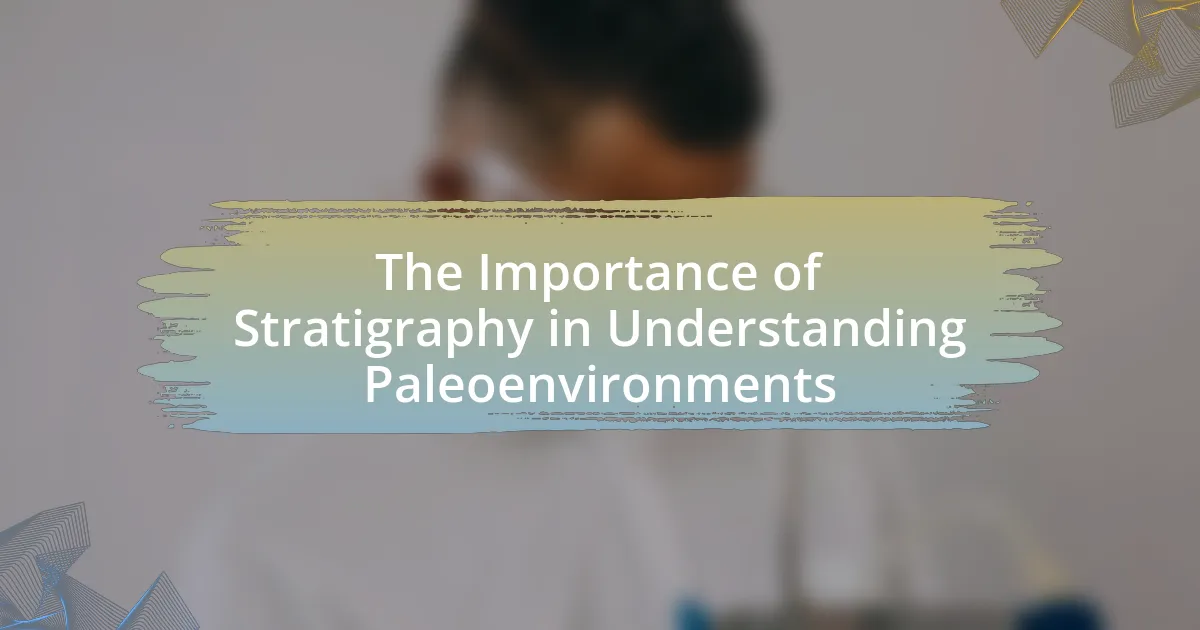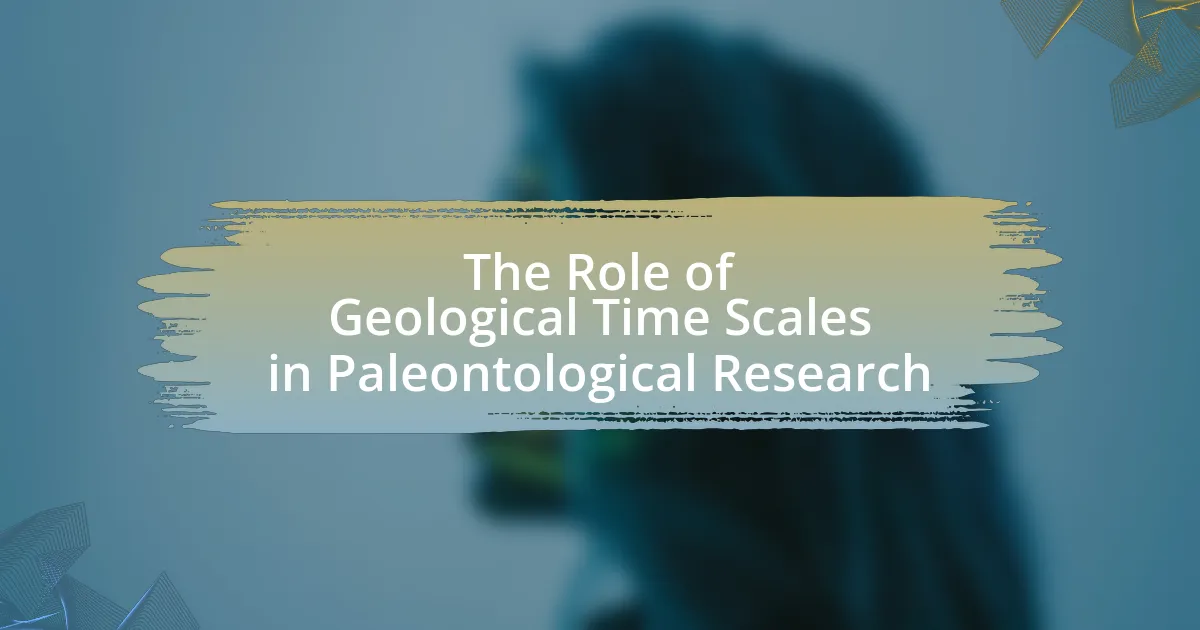Fossilization processes refer to the natural events that lead to the preservation of organic remains as fossils, primarily through burial, mineralization, and the replacement of organic material with minerals. This article explores how these processes occur in nature, detailing the stages involved, the influence of environmental and geological factors, and the significance of fossilization in understanding Earth’s history and evolution. Key types of fossilization, such as permineralization and cast and mold formation, are examined, along with the impact of sediment type, climatic conditions, and natural disasters on fossil preservation. The article emphasizes the practical implications of fossilization processes for paleontology and fossil recovery, highlighting best practices for studying these critical geological phenomena.
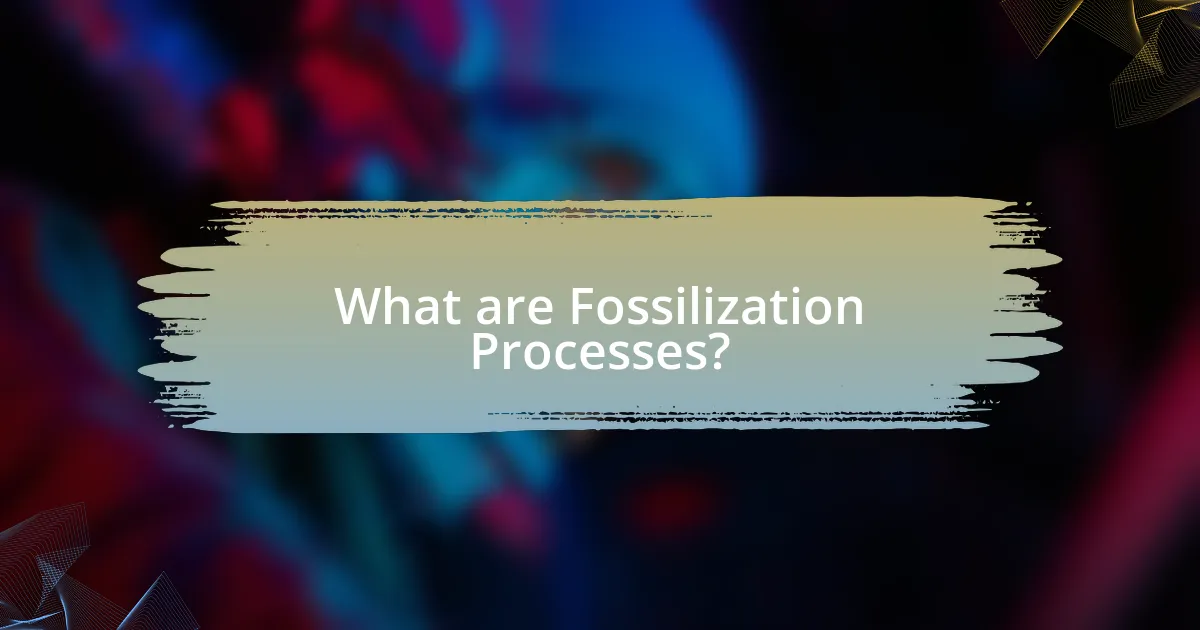
What are Fossilization Processes?
Fossilization processes are the series of natural events that lead to the preservation of organic remains as fossils. These processes typically include burial, mineralization, and the replacement of organic material with minerals over time. For instance, when an organism dies, rapid burial under sediment can protect it from decay and scavengers, allowing for the conditions necessary for fossilization to occur. Additionally, mineralization involves the gradual infiltration of minerals into the organic remains, which can preserve the structure and details of the original organism. Fossilization is further influenced by geological factors such as sediment type, pressure, and temperature, which can affect the rate and quality of fossil preservation.
How do Fossilization Processes occur in nature?
Fossilization processes occur in nature primarily through the preservation of organic remains in sedimentary environments. When organisms die, their remains can be buried by sediment, which protects them from decay and scavenging. Over time, minerals in groundwater can infiltrate these remains, replacing organic material and forming fossils through processes such as permineralization, where minerals fill the cellular spaces, or cast and mold formation, where the original material dissolves, leaving a cavity that can be filled with minerals. Geological factors such as sedimentation rates, the presence of water, and the type of sediment play crucial roles in determining the likelihood and type of fossilization. For instance, rapid burial in anoxic conditions significantly enhances preservation, as seen in the fossilization of marine organisms in deep-sea sediments.
What are the stages involved in Fossilization Processes?
The stages involved in fossilization processes include burial, preservation, and mineralization. During burial, organic remains are quickly covered by sediment, which protects them from decay and scavengers. Preservation occurs when the conditions, such as low oxygen levels, inhibit decomposition. Finally, mineralization happens when minerals from surrounding sediments infiltrate the organic material, replacing it and forming a fossil. This sequence is supported by geological evidence showing that rapid burial and specific environmental conditions are crucial for successful fossilization.
How do environmental conditions influence Fossilization Processes?
Environmental conditions significantly influence fossilization processes by determining the rate and effectiveness of organic material preservation. Factors such as temperature, moisture, sediment type, and oxygen levels directly affect how quickly and thoroughly organisms can be buried and mineralized. For instance, low oxygen environments, like deep ocean floors or swamps, slow down decomposition, allowing for better preservation of remains. Additionally, rapid burial in fine sediments can protect remains from scavengers and physical weathering, enhancing fossilization potential. Geological evidence shows that fossilization is more prevalent in sedimentary rock formations where these favorable conditions are met, as seen in the Burgess Shale, which contains exceptionally well-preserved fossils due to its unique depositional environment.
Why are Fossilization Processes important in geology?
Fossilization processes are important in geology because they provide critical insights into the history of life on Earth and the environmental conditions of past eras. These processes allow for the preservation of biological remains, which can be studied to understand evolutionary changes, extinction events, and ancient ecosystems. For instance, the fossil record reveals that over 99% of all species that have ever lived are now extinct, highlighting the dynamic nature of life and the impact of geological events on biodiversity. Additionally, fossils serve as key indicators for dating geological strata, aiding in the reconstruction of Earth’s geological timeline and the understanding of plate tectonics and climate change over millions of years.
What insights do Fossilization Processes provide about Earth’s history?
Fossilization processes provide critical insights into Earth’s history by revealing information about past life forms, environmental conditions, and geological events. These processes, such as permineralization and amber preservation, allow scientists to reconstruct ancient ecosystems and understand evolutionary changes over millions of years. For instance, the fossil record indicates mass extinction events, like the Permian-Triassic extinction, which eliminated approximately 90% of species, highlighting significant shifts in biodiversity and climate. Additionally, isotopic analysis of fossils can inform researchers about ancient climates and atmospheric compositions, further elucidating the planet’s geological and biological evolution.
How do Fossilization Processes contribute to our understanding of evolution?
Fossilization processes significantly enhance our understanding of evolution by preserving biological evidence that illustrates the morphological and behavioral changes of organisms over time. These processes, such as permineralization, cast formation, and amber preservation, allow scientists to study the physical characteristics of extinct species, providing insights into their adaptations and ecological roles. For instance, the fossil record reveals transitional forms, such as Archaeopteryx, which demonstrates the evolutionary link between dinosaurs and birds, supporting the theory of descent with modification. Additionally, the stratigraphic context of fossils helps establish timelines for evolutionary events, allowing researchers to correlate changes in biodiversity with environmental shifts, such as mass extinctions. Thus, fossilization processes serve as a crucial tool in reconstructing the history of life on Earth and understanding the mechanisms of evolution.
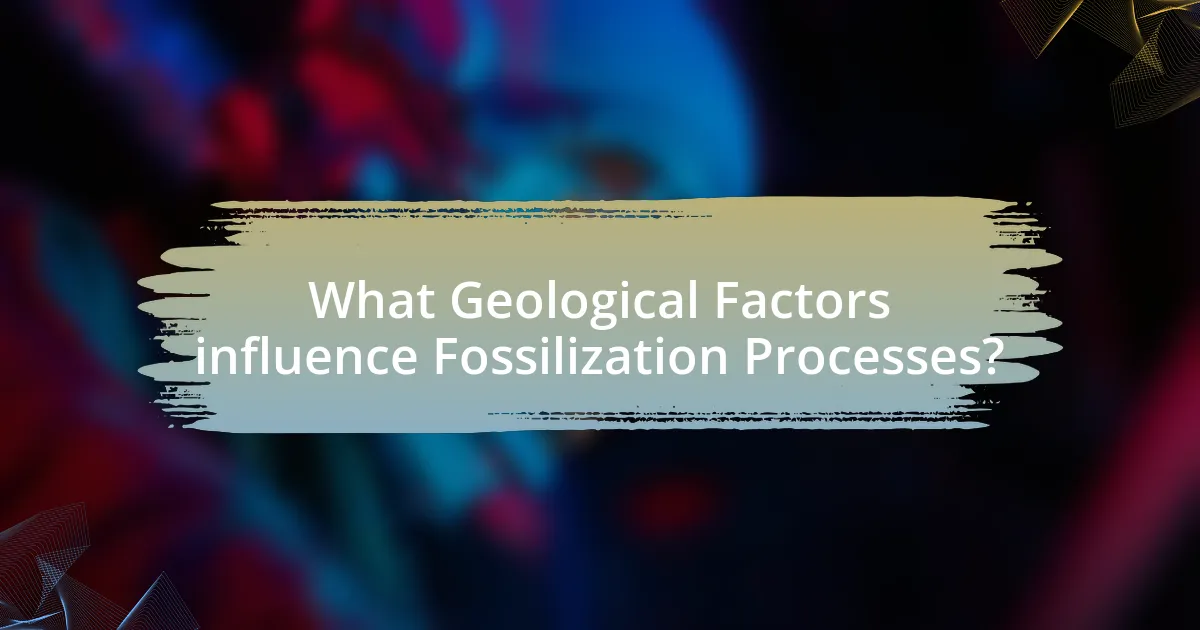
What Geological Factors influence Fossilization Processes?
Geological factors that influence fossilization processes include sediment type, burial depth, temperature, and the presence of water. Sediment type affects the preservation of organic material; fine-grained sediments, like clay, are more conducive to fossilization than coarse sediments, as they provide better protection against decay. Burial depth plays a critical role, as deeper burial can increase pressure and temperature, facilitating chemical processes that promote fossilization. Additionally, higher temperatures can accelerate mineralization, while the presence of water is essential for transporting minerals that replace organic material, leading to fossil formation. These factors collectively determine the likelihood and quality of fossil preservation in geological contexts.
How does sediment type affect Fossilization Processes?
Sediment type significantly influences fossilization processes by determining the conditions under which organic remains are buried and preserved. For instance, fine-grained sediments, such as clay, facilitate the preservation of delicate structures due to their ability to create an anoxic environment that slows decomposition. In contrast, coarse sediments, like sand, may lead to rapid erosion or disturbance, hindering fossil formation. Research indicates that environments with high sedimentation rates, such as river deltas, enhance fossilization by quickly burying remains, while low-energy environments, like deep-sea floors, can also preserve fossils effectively due to reduced disturbance. Thus, the characteristics of sediment directly impact the likelihood and quality of fossil preservation.
What role do sedimentary environments play in Fossilization Processes?
Sedimentary environments are crucial in fossilization processes as they provide the necessary conditions for the preservation of organic remains. These environments, such as riverbeds, lakes, and ocean floors, facilitate the accumulation of sediments that can bury and protect biological materials from decay and scavenging. For instance, rapid sedimentation in a deltaic environment can quickly cover remains, reducing exposure to oxygen and microbial activity, which are detrimental to preservation. Additionally, the mineral composition of sediments can influence the chemical processes that lead to fossilization, such as permineralization and replacement. Studies have shown that fossilization rates are significantly higher in anoxic conditions typical of certain sedimentary environments, underscoring their role in enhancing the likelihood of fossil preservation.
How does the mineral composition of sediments impact Fossilization Processes?
The mineral composition of sediments significantly impacts fossilization processes by influencing the preservation and chemical interactions of organic materials. For instance, sediments rich in silica can enhance the preservation of delicate structures, while calcium carbonate-rich sediments may promote the formation of fossils through mineral replacement. Additionally, the presence of specific minerals can affect the pH and redox conditions of the sediment, which in turn influences microbial activity and the rate of decomposition. Research indicates that sediments with higher clay content can better preserve fossils due to their ability to retain moisture and create an anaerobic environment, reducing decay rates. Thus, the mineral composition directly affects the likelihood and quality of fossilization by altering the physical and chemical conditions surrounding organic remains.
What climatic conditions are conducive to Fossilization Processes?
Fossilization processes are most conducive in warm, humid climates with low oxygen levels. These conditions promote rapid burial and preservation of organic material, reducing decay and allowing for mineralization. For instance, tropical environments often provide the necessary warmth and moisture, while anaerobic conditions, such as those found in swamps or deep ocean floors, inhibit decomposition. Studies show that fossilization is significantly more successful in these environments compared to arid or highly oxygenated areas, where organic remains are more likely to decompose before fossilization can occur.
How do temperature and humidity affect Fossilization Processes?
Temperature and humidity significantly influence fossilization processes by affecting the rate of decomposition and mineralization of organic materials. Higher temperatures can accelerate decomposition, reducing the likelihood of fossil formation, while lower temperatures can slow down this process, allowing for better preservation. Humidity levels also play a crucial role; high humidity can promote the growth of bacteria and fungi, which can lead to rapid decay, whereas low humidity can inhibit microbial activity, favoring fossilization. For instance, the fossilization of organisms in arid environments, where low humidity prevails, often results in better preservation compared to those in humid, tropical settings.
What is the impact of natural disasters on Fossilization Processes?
Natural disasters significantly disrupt fossilization processes by altering sedimentation patterns and environmental conditions. Events such as earthquakes, volcanic eruptions, and floods can rapidly bury organic material, which may enhance preservation under certain conditions. For instance, volcanic ash can create an anaerobic environment that slows decay, while floods can transport and deposit sediments that encapsulate remains. However, these disasters can also lead to erosion and destruction of potential fossil sites, ultimately affecting the fossil record. Historical examples include the preservation of organisms in volcanic ash layers, as seen in the La Brea Tar Pits, where rapid burial contributed to exceptional fossilization.
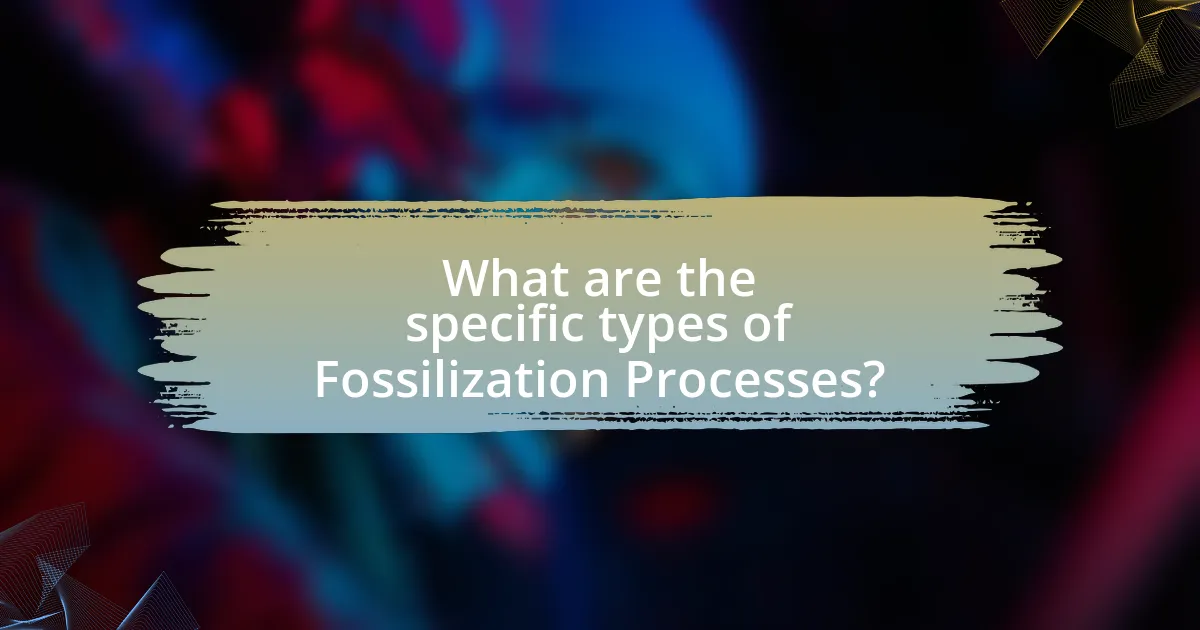
What are the specific types of Fossilization Processes?
The specific types of fossilization processes include permineralization, cast and mold fossilization, amber preservation, and carbonization. Permineralization occurs when mineral-rich water permeates organic material, leading to the deposition of minerals within the structure, often seen in petrified wood. Cast and mold fossilization involves the formation of a mold from the original organism, which can later be filled with sediment to create a cast. Amber preservation happens when organisms are trapped in tree resin that hardens over time, preserving them in remarkable detail. Carbonization is the process where organic material is compressed, leaving a carbon residue that outlines the original organism. Each of these processes provides unique insights into the past, demonstrating how geological factors influence fossil formation.
What is permineralization and how does it occur?
Permineralization is a fossilization process where mineral deposits form internal casts of organisms. This occurs when groundwater rich in minerals permeates the porous structures of organic material, such as bones or wood. Over time, the minerals precipitate out of the water and fill the empty spaces within the organic material, effectively replacing the original organic material with minerals like silica, calcite, or pyrite. This process preserves the fine details of the organism’s structure, allowing for the creation of detailed fossil records.
What are the key characteristics of permineralized fossils?
Permineralized fossils are characterized by the preservation of organic material through the infiltration of minerals, which fill the cellular spaces and harden over time. This process typically occurs in environments where sedimentation is rapid, allowing minerals from groundwater to permeate the remains before decomposition can occur. The result is a fossil that retains detailed internal structures, such as cell walls and tissues, often with a high degree of fidelity to the original organism. Evidence of this process can be seen in fossils like petrified wood, where the original organic material is replaced by silica, preserving the wood’s structure while mineralizing it.
How does permineralization differ from other Fossilization Processes?
Permineralization differs from other fossilization processes by involving the deposition of minerals within the organic tissues of an organism, effectively preserving its structure in detail. In contrast, processes like carbonization primarily involve the removal of volatile substances, leaving behind a carbon-rich residue, while molds and casts replicate the external shape without preserving internal details. The mineralization in permineralization often occurs in environments rich in groundwater, where minerals like silica or calcite infiltrate the organic material, leading to a more durable fossil. This method allows for the preservation of fine anatomical features, which is not typically achieved in other fossilization methods.
What is cast and mold fossilization?
Cast and mold fossilization is a process where the shape of an organism is preserved in sedimentary rock through two distinct forms: molds and casts. A mold forms when an organism leaves an impression in the sediment, which hardens, creating a negative imprint of the organism’s shape. Subsequently, a cast occurs when minerals fill this mold, creating a three-dimensional replica of the original organism. This process is significant in paleontology as it allows for the preservation of detailed anatomical features, providing insights into the organism’s structure and the environment in which it lived.
How do casts and molds form during Fossilization Processes?
Casts and molds form during fossilization processes through the preservation of organic remains in sediment. When an organism dies, its remains may be buried by sediment, which hardens over time. A mold occurs when the original material decays, leaving an impression in the sediment. Subsequently, if minerals fill this impression, a cast is created, replicating the shape of the original organism. This process is supported by geological evidence, such as the discovery of fossilized molds and casts in sedimentary rock layers, which demonstrate the conditions under which these fossils formed.
What are the differences between casts and molds in fossil records?
Casts and molds are two distinct types of fossil imprints that differ in their formation and structure. A mold is created when an organism leaves an impression in sediment, which hardens, preserving the shape of the organism but not the organism itself. In contrast, a cast forms when the mold is filled with minerals or sediment, creating a three-dimensional replica of the original organism. This distinction is supported by fossilization examples, such as the molds of dinosaur footprints found in sedimentary rock, which show the shape of the foot, while casts of the same footprints can be created by filling those molds with plaster or mineral deposits, resulting in a detailed replica.
What practical implications do Fossilization Processes have for paleontology?
Fossilization processes have significant practical implications for paleontology, as they determine the conditions under which organisms are preserved and the types of fossils that can be studied. These processes influence the availability of fossilized remains, which are crucial for reconstructing past ecosystems, understanding evolutionary history, and dating geological strata. For instance, the rapid burial of organisms in sedimentary environments enhances preservation, while factors such as mineral composition and environmental conditions dictate the quality and type of fossils formed. Studies have shown that specific fossilization conditions, such as anoxic environments, lead to exceptional preservation of soft tissues, providing invaluable insights into the biology of ancient organisms.
How can understanding Fossilization Processes aid in fossil recovery?
Understanding fossilization processes aids in fossil recovery by providing insights into the conditions necessary for fossil preservation. Knowledge of these processes, such as sedimentation rates, mineralization, and environmental factors, allows paleontologists to identify potential fossil sites more effectively. For instance, fossils are more likely to be found in sedimentary rock formations where rapid burial occurs, which protects organic material from decay. Additionally, understanding the chemical processes involved in fossilization, such as permineralization, helps researchers determine the best methods for excavation and preservation. This knowledge is supported by studies indicating that specific geological settings, like river deltas or lake beds, are conducive to fossil formation, thereby guiding recovery efforts in those areas.
What best practices should be followed when studying Fossilization Processes?
When studying fossilization processes, researchers should prioritize a multidisciplinary approach that integrates geology, paleontology, and chemistry. This approach allows for a comprehensive understanding of the environmental conditions and biological factors influencing fossilization. For instance, examining sedimentary rock layers can reveal the depositional environment, while chemical analyses can identify mineral compositions that affect preservation. Additionally, utilizing modern imaging techniques, such as CT scanning, enhances the ability to visualize internal structures without damaging specimens. These practices are supported by studies indicating that a combination of geological context and advanced technology significantly improves the accuracy of fossil interpretation and preservation assessments.
